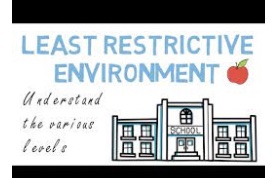Special education is a crucial aspect of the educational system that caters to students with disabilities. One of the most significant principles in special education is the Least Restrictive Environment (LRE), which aims to provide an inclusive and supportive environment for disabled students. The concept of LRE is based on the idea that every student should have equal opportunities in their learning experience regardless of their disability status. It recognizes that placing students in separate classrooms or schools away from non-disabled individuals can be stigmatizing and isolating. In this article below, I will walk you through a few benefits, legal basis, challenges, and best practices to implementing the Least Restrictive Environment LRE. To learn about them, be sure to give this article a read.
Benefits of Least Restrictive Environment (LRE)
LRE means students with disabilities should be placed in regular classrooms whenever possible. It allows them to interact with their peers without disabilities and learn from them. There have several benefits of LRE for students with disabilities and those without.
-
Socialization
One advantage of LRE is that it promotes socialization and integration among all children. Students with disabilities will get more opportunities to make friends, learn new skills, and become active members of their communities.
-
Academic Achievement
Another benefit of LRE is that it can improve academic outcomes for all students. When students work together in an inclusive setting, they can share their knowledge and skills, which may lead to better understanding and higher achievement levels for everyone involved.
-
Inclusion
Inclusion is more than just a buzzword; children with disabilities must thrive in their educational environments. One of the most important aspects of inclusion is providing students with access to the least restrictive environment (LRE). Students with disabilities who receive instruction in inclusion tend to have stronger self-esteem and confidence, which can lead to more positive attitudes toward school and life in general. Moreover, inclusion promotes diversity and creates opportunities for all children to learn from one another.
Legal Basis for LRE
Two federal laws firmly establish the legal basis for the Least Restrictive Environment (LRE), the Individuals with Disabilities Education Act (IDEA) and the Americans with Disabilities Act (ADA). These two laws provide a framework of rights and protections for students with disabilities in educational settings and prohibit discrimination against them.
IDEA mandates that every child is entitled to a free appropriate public education (FAPE), including access to a general education curriculum and extracurricular activities. It also requires that schools provide special education services in the least restrictive environment possible, meaning that children should be educated alongside their non-disabled peers whenever feasible.
The ADA further reinforces these principles by prohibiting discrimination against individuals with disabilities in all areas of public life, including education.
Challenges to Implementing LRE
LRE means that students with disabilities should be educated alongside their non-disabled peers to the maximum extent appropriate. Although IDEA guarantees this right to all students, there are several challenges to implementing LRE in practice.
One major challenge faced by schools and educators is a lack of resources. Providing accommodations and modifications for students with disabilities can be expensive, and many schools struggle to find adequate funding. Another challenge is resistance from parents or others who may believe that inclusion will not meet their child’s needs. Some parents may have concerns about how their child will adjust socially or academically in an inclusive classroom setting.
Best Practices for Implementing LRE
Implementing LRE requires careful planning and collaboration between educators, administrators, families, and students. Administrators must create an environment where inclusion is celebrated and supported throughout the school system. Teachers need to work together to create a curriculum that meets all learners’ diverse needs while providing individualized support where needed. Parents must be involved from the beginning stages of planning to ensure their child’s needs are addressed appropriately within inclusive classrooms.




